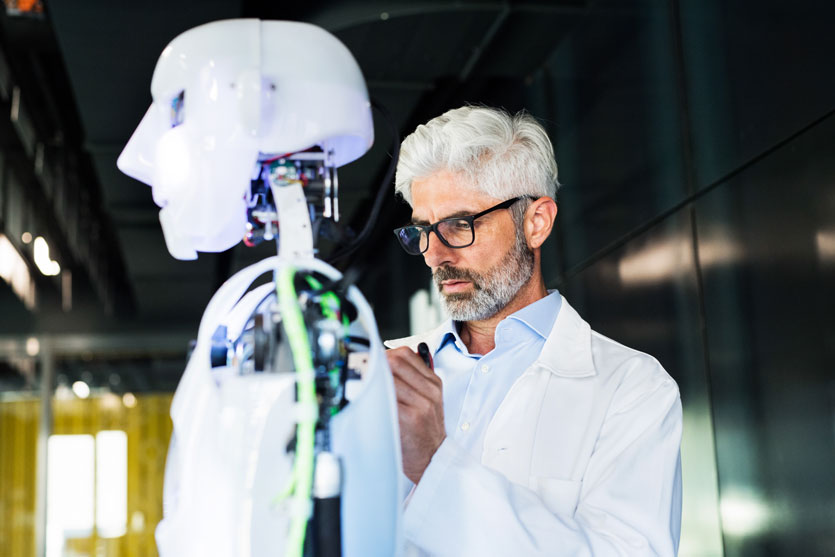When Machines And People Work In Perfect Harmony
May 14, 2019

by Daren Ward
LONDON - The transformation of the workplace has
come quickly, suddenly and stealthily and invaded more aspects of our lives
than we likely recognise. It’s the march of automation; the invasion of the
robots, if you like. Whether you term it as the Fourth Industrial Revolution,
or just call it progress, our workplace is changing almost by the day.
Over the next 5 years the World Economic Forum estimates that artificial intelligence and robotics will create 58 million more jobs than they eliminate. But they will be ‘new’ jobs, requiring different skills and a different mindset.
Our own study on Human Machine Interfaces shows that people are looking for products and services that work smoothly, save time and ultimately increase comfort. That requires machines that are more intuitive and with natural interfaces.
Technology is increasingly in demand as a
tool for expanding or improving a person’s abilities and sense. We are moving
from the age of ‘hands and touch’ to one of ‘minds and body’.
Some of these tools are already with us. Voice assistance and chatbots speed up processing or automated tasks, for instance. They are especially useful in CRM environments, where a bot can automate the first stages of a customer enquiry before needing human assistance.
Other technologies, such as extended reality - a leap beyond virtual reality - are also coming to fruition. Many experts believe that full immersion, where the mind becomes one with a computer, is not that far away.
Related: Five ways AI will change the future of work
Machine
learning and interaction
People in almost every walk of working life
have experienced some form of automation in the past few years. That could be
on the factory floor with robotic assistance, or in the office with software
that enhances productivity. We call this process
automation – the way that machines can automate repetitive or simple tasks.
Human interaction with machines is a key part of this equation as we change our own ways of working to find efficiencies with technology. For example, because speech is a much faster information interchange than typing information onto a keyboard, chatbots are finding a real place in sales and customer service environments.
There is an expectation that chatbots can understand and interpret nuances of language, fathom dialects or hold a ‘natural’ conversation. There are still obvious limits to these tools, but at the same time, there is little doubt they can speed up the process of interaction with a company and the technology continues to improve. The acid test will be when we can’t spot the difference between man and machine.
Machines are also allowing us to do our jobs much more effectively; there is a car insurance company for instance, that is already using photographs to automatically process car damage claims without needing a human assessor. The aim is to convert images to 3D soon to provide an even more accurate damage assessment.
Related: Looking at automation and the future of work
Machines are no longer dumb waiters. They
can learn and adapt by following their human masters, a term defined as ‘machine-learning’. They follow processes
taken to reach an end-point and learn the logic behind each decision. This enables
the computer, robot, machine, whichever way you want to describe it, to adapt
to the task they need to complete.
But AI is only as good as the quality and
quantity of data we hold. The insurance company needs to hold data on every
type of car accident, on every make and model or car, to make a confident assessment
of every damage claim, for instance.
We can also use data to predict patterns of
behaviour and get us to react in different ways. This is what we call predictive automation.
We work with a shoe chain in Italy that is
using AI to assess which brands of shoes are most popular, based on store
location, age and the demographics of its customer base. Using this analysis,
AI can provide feedback recommendations for new or enhanced designs to its
production team. It is predicting what people want to buy based on their past
preferences and patterns of consumption. In the process it has slashed response
times in the design and production cycle from 6 months to a week.
The chain is now automatically monitoring
comments on its social media channel to feed into more design and
decision-making processes – there are too many for a human to respond to 24/7,
so the machine is doing it for them.
The
psychology of man and machine
The beauty of machine applications is that
they can, in theory, free humans from the mundane, tedious and repetitive tasks
that many of us do on a day-to-day basis. They can release the time for us to
get on with more creative, value-added or complex tasks that requires more
thought and intuition.
In practice, the pace of change could be too
fast for many of us to find comfortable. People are, by their nature, resistant
to change. They settle into routines and habits and, in many cases, are
reluctant to upskill and retrain. So, there will be an amount of upheaval, even
resistance, as we settle in with our robotic counterparts.
We’ve surrounded ourselves with machines for a long time now whether it was the steam engine or the computer. It has always meant change. But with change comes improvements in productivity and creativity. Our challenge is not to fear the unknown, but to appreciate and maximise the opportunities that the Fourth Industrial Revolution can really provide for us in the next few years. It is up to us to use it wisely.
Join Daren and the Reply team with over 20,000 senior decisionmakers in the enterprise and technology world at The AI Summit London, June 12-13. Find out more
Daren Ward is an Executive Partner at Reply
About the Author(s)
You May Also Like


.jpg?width=700&auto=webp&quality=80&disable=upscale)
.jpg?width=700&auto=webp&quality=80&disable=upscale)
.jpg?width=700&auto=webp&quality=80&disable=upscale)
.jpg?width=300&auto=webp&quality=80&disable=upscale)
.jpg?width=300&auto=webp&quality=80&disable=upscale)
.jpg?width=300&auto=webp&quality=80&disable=upscale)

